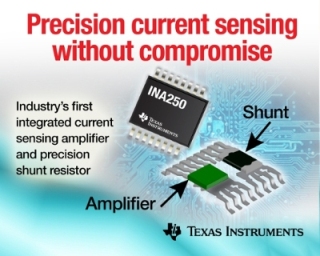Jul 13 2015
Texas Instruments (TI) today introduced the industry's first current-sense amplifier to integrate a high-precision, low-drift shunt resistor, which can deliver highly accurate measurements over a wide temperature range. TI's INA250 integrates the shunt resistor with a bi-directional, zero-drift current-sense amplifier to support both low-side and high-side implementations.
Its accuracy and low drift reduce or may eliminate designers' calibration effort for many systems. This integration also enables lower system cost and a smaller board footprint compared to competitive solutions. For more information about the INA250 current-sense amplifier, see www.ti.com/INA250-pr.
 TI makes high-accuracy measurement more attainable with the first current-sense amplifier to integrate a high-precision, low-drift shunt resistor
TI makes high-accuracy measurement more attainable with the first current-sense amplifier to integrate a high-precision, low-drift shunt resistor
By enabling high-accuracy measurement along with low system cost and a small board footprint, the INA250 current-sense amplifier delivers higher performance to applications such as test and measurement, communications load monitoring, and power supplies. Test and measurement designers can achieve required performance levels and potentially eliminate calibration while reducing cost up to 76 percent. High-performance enterprise and telecom equipment designers can achieve distributed measurement to maximize system efficiency and enhance system management.
Key features and benefits of the INA250 current-sense amplifier
- Industry's most accurate integrated solution:
- The integrated 2-milliohm shunt resistor offers 0.1 percent tolerance as well as low drift of 15 pmm/ºC from -40ºC to 125ºC, enabling higher performance of the end equipment.
- The amplifier offers offset current of 12.5 mA with temperature drift of 250 µA/ºC and gain drift of 30 ppm/ºC.
- The integrated packaging technology ensures an optimized Kelvin connection between the IC and the resistor.
- The amplifier enables a maximum error of 0.75 percent over the temperature range of -40ºC to +125ºC.
- Reduces system cost up to 76 percent and the board footprint up to 66 percent compared to competitive solutions by integrating the shunt resistor.
- Low power consumption: Maximum power consumption of 300 µA minimizes the load that the measurement methodology adds to the system.
Tools and support to speed design
The INA250 evaluation module (EVM) enables designers to quickly and easily evaluate the device's accuracy. The INA250EVM is available from the TI store and authorized distributors for US$49. INA250 TINA-TI and TINA-TI Spice models are available for download.
Support is available in the TI E2E™ community Current Shunt Monitors Forum, where engineers can search for solutions, get help, share knowledge and solve problems with fellow engineers and TI experts.
Package, availability and pricing
The INA250 current-sense amplifier comes in a 5-mm-by-6.4-mm thin-shrink small outline package (TSSOP). It is available now, priced at US$1.40 in 1,000-unit quantities. Three other gain options will be available in 4Q15, allowing designers to optimize full-scale output voltage based on the target current range.
The INA250 is the latest addition to TI's growing portfolio of innovative current-sense amplifiers that offers a leading combination of power, size and accuracy. See TI's entire current-sense amplifier portfolio.
Learn more about TI's current-sense amplifiers
- Read blog posts about designing with current-sense amplifiers.
- Watch training videos about the INA250 current-sense amplifiers.
- Learn about TI's innovative sensing portfolio.